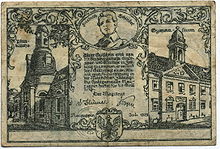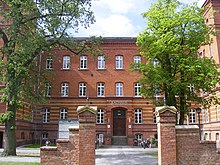Neuruppin
Neuruppin (German: [nɔʏ.ʁʊ.ˈpiːn] ⓘ; North Brandenburgisch: Reppin) is a town in Brandenburg, Germany, the administrative seat of Ostprignitz-Ruppin district.
In the northern foreland a market settlement with Nikolai church developed, east of it and beyond the Rhin the Kietz: the town (Olden Ruppyn) Alt Ruppin had arisen.
Southwest of the castle town, the settlement of today's Neuruppin with Nikolaikirche (St. Nicholas' Church) and a street market was established at the beginning of the 13th century, keeping the name Ruppin.
An expansion of the original Marktsiedlung Alt Ruppin, towards the present-day city of Neuruppin, probably took place before the foundation of the Dominican monastery in 1246 as the first settlement of the order between the Elbe and Oder rivers by the first prior Wichmann von Arnstein.
Long wide streets interrupted by stately plazas, and houses in a transformation architecture mixing Baroque, Mannerist and Gothic design elements with Neoclassical trends,[11][12] have shaped the townscape since that time.
Only the completion of the parish church of St. Mary (built 1801-1806 by Philipp Bernard François Berson with the collaboration of Carl Ludwig Engel) dragged on until 1806 due to structural problems.
Johann Bernhard Kühn (1750-1826) began producing picture sheets in Neuruppin, thematically designed and for a long time as hand-colored broadsides.
Three other companies produced the popular picture sheets: Philipp Oehmigke, Hermann Riemschneider, and Friedrich Wilhelm Bergemann.
His works include organs in the churches of the districts of Bechlin, Buskow, Karwe, Nietwerder and Storbeck as well as the Siechenhauskapelle in the old town of Neuruppin.
[9] After the Nazis seized power in June 1933, more than 80 political opponents of the regime, mainly Social Democrats, Jews, and Communists, were taken to a provisional prison run by the SA within the buildings of a brewery on Altruppiner Allee, which had been shut down at that time.
Since November 17, 2003, Stolpersteine ("stumbling stones") markers in the core city and in Alt-Ruppin have commemorated the murdered Jewish residents.
On September 20, 2004, six Stolpersteine were laid on the grounds of the Ruppiner Kliniken in memory of the euthanasia victims of the former state lunatic asylum.
In 1989, massive demonstrations by Neuruppin residents in connection with plans for the continued use of the Wittstock military training and air-to-ground firing range led to the closure of the airfield.
From 1970, they were expanded as Elektro-Physikalische Werke (EPW) to become the largest printed circuit board manufacturer in the GDR, employing up to 3,500 workers.
As a result of the fall of the Berlin Wall and the peaceful revolution in the GDR, the state of Brandenburg was reestablished in 1990, while the district of Neuruppin remained in existence for the time being.
Beginning in the 1970s, VEB Elektrophysikalische Werke Neuruppin was established to handle all printed circuit board production for the GDR's microelectronics and entertainment technology industries.
The construction of a four-lane expressway following the model of an automotive city - leading from Fehrbelliner Strasse along the present Regattastrasse via Bollwerk, crossing Seedamm / Steinstrasse, in the direction of Wittstocker Allee[20] - was opposed by financial constraints in the GDR.
Neuruppin grew from a small town with about 18,000 inhabitants to 33,000 inhabitants between 1970 and 1989 through the settlement and expansion of technology and industry, which was economically significant for the GDR and the RGW states and as exports to the NSW (non-socialist economic area) in exchange for foreign currency, due to an influx of differently educated people from all parts of the GDR.
Added to this were the many foreign workers and apprentices from the allied socialist states of Vietnam, Angola, Cuba, and the Soviet armed forces stationed there with around 12,000 men (including their families).
On the same day, Neuruppin was significantly enlarged by incorporating the town of Alt Ruppin as well as the communities of Buskow, Gnewikow, Gühlen-Glienicke, Karwe, Krangen, Lichtenberg, Molchow, Nietwerder, Radensleben, Stöffin, Wulkow and Wuthenow.
[22] On January 1, 2001, the focal public prosecutor's office for corruption was established in Neuruppin as the successor to the department for GDR injustices and district crime.
The municipal election on May 26, 2019, with a voter turnout of 49.0%, resulted in the following:[32] The AfD accounted for four seats in line with its share of the vote, two of which remain unoccupied because the party nominated only two candidates.
[37][38] The former CDU city councilor Olaf Kamrath was legally sentenced in 2006 as the head of the XY gang to many years in prison for, among other things, gang-related narcotics offences.
[37] In 2007, the verdict against former city councilor Reinhard Sommerfeld (Neuruppiner Initiative) was the only legally binding conviction of an elected official in Germany for bribery of members of parliament to date.
On May 15, 2008, former state parliament member Otto Theel (Die Linke) was given a nine-month suspended prison sentence for taking advantage in office during his term as mayor of Neuruppin.
[40] In September 2008, Sparkasse Ostprignitz-Ruppin parted ways with its previous CEO Josef Marckhoff, who had his employer throw him a circa 55,000 euro celebration to mark his own 60th birthday.
[37] The former managing director of the municipal public utility company Neuruppin Dietmar Lenz was sentenced to a suspended prison sentence of two years on March 19, 2009, on charges of a serious breach of trust and acceptance of benefits, having spent more than 500,000 euros bypassing the supervisory board to support the sports club MSV Neuruppin.
[38][42] As of January 1, 2016, Neuruppin became the sixth corporate municipal member of Transparency International, along with Bonn, Hamm (Westphalia), Potsdam, Leipzig, and Halle (Saale).
[48] The action alliance was able, through broad civil society engagement, with cultural stage program on the school square and a blockade for the first time to stop the so-called "Day of the German Future".
Blazon: "In blue a silver castle with two pinned, two-storey towers with two superimposed black gates and gold-knobbed, red pointed roofs; the central building with three turrets and a black gate, which is covered by a red triangular shield, topped with a gold-armed and gold-tongued silver eagle.".









